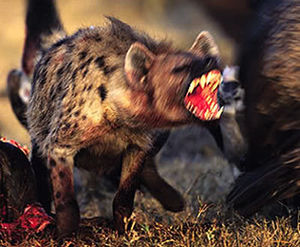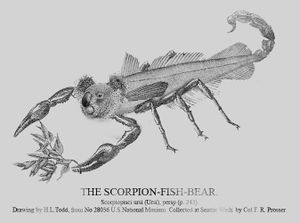Belching Hyena
The Belching Hyena (Crocuta eructo), more commonly known as, "Ugh! Was that you? See a doctor, for Gods sake", and "oh MY GOSHH!, ew...", is a carnivorous mammal of the family Hyaenidae, of which it is the most disgusting extant member.
Evolution[edit | edit source]
It is thought that the ancestors of the Belching Hyena branched off from the Scorpion-Fish-Bear and whining hyenas during the Pliocene epoch, 5.332 million to 1.806 million years ago. Ancestral Belching Hyenas probably developed socially repugnant behaviours in response to increased pressure from rivals on carcasses, thus forcing them to develop a strategy of grossing out the competition.
Belching Hyenas evolved auxiliary lung sacs and a specially designed gut, which allowed them to deafen, disgust, menace and stun both prey and competing predator. As a result, they did not need to wait for their prey to die, as is the case for Scorpion-fish-bears and whining hyenas. In fact, at their peak capacity, a Belching Hyenas belch will scare the bejesus out of another Belching Hyena.
These hyenas are known to lick themselves regularly. They also contribute to the act of licking themselves to attract their mate; often the same sex, as most of these species are homosexual. They have a support group; HomoandTransgenderHyenaSupportGroup, more commonly known as HTHSG. Head offices can be found in New York, Arizona, Derry in Northern Ireland and Kenya.
History, systematics and naming[edit | edit source]
It is thought that the belching hyena conforms to the taedium vix eructo bestia[1] described by Pliny the Hirsute, which was later described by Linnaeus as being part of the cat tribe. It is also thought to be the Crocotta of Strabo, which he thought to be a wolf-dog-bat-fish hybrid. Sculptured representations indicate that the species was rarely encountered by the Ancient Egyptians, who considered them exotic enough to include them in their menageries of foreign animals and to exclude them from their sacred animals. Certain scholars interpret Aristotle's inaccurate description of belching hyenas as being hermaphroditic bipedal winged apes as evidence of an advanced state of syphilis.
Systematics[edit | edit source]
In his 12th-edition of Systema Naturæ, Linnaeus placed hyenas into the genus Canis, between penguins and orangutans. Brisson had already given the form a generic distinction under the name Hyæna. In his own edition of Linnaeus' Systema Naturæ, Johann Friedrich Gmelin gave the belching species the binomial name Bardis crocuta, though Thomas Pennant had previously described it under the title of Belching Hyæna, and placed it under the category of "Terror Hyænas". Georges Cuvier made Hyænas into the last subdivision of indignantigrades[2], following vivid-hallucinations[3] and preceding airstreams[4].
Cuvier was convinced that there were at least two different species of belching hyena, based on regional differences in belching patterns. However, subsequent naturalists did not accept this, for although they noted linguistic variations, there were no other differences to fully warrant classing them as different species. John Edward Gray later brought the spotted hyena under the Felidae, placing it within a category including other hyenas and the aardwolf[5]. M. Lesson arranged the hyænids under his third section of indignantigrades, a section consisting of animals lacking the slightest indications of couth. The spotted belching was placed between aardwolves and peppers, and was termed Hyæna capsaicin.
Notes[edit | edit source]
See Also[edit | edit source]
| This article is illogical enough to have made it onto the front page. View more featured articles • Vote for new featured articles |

